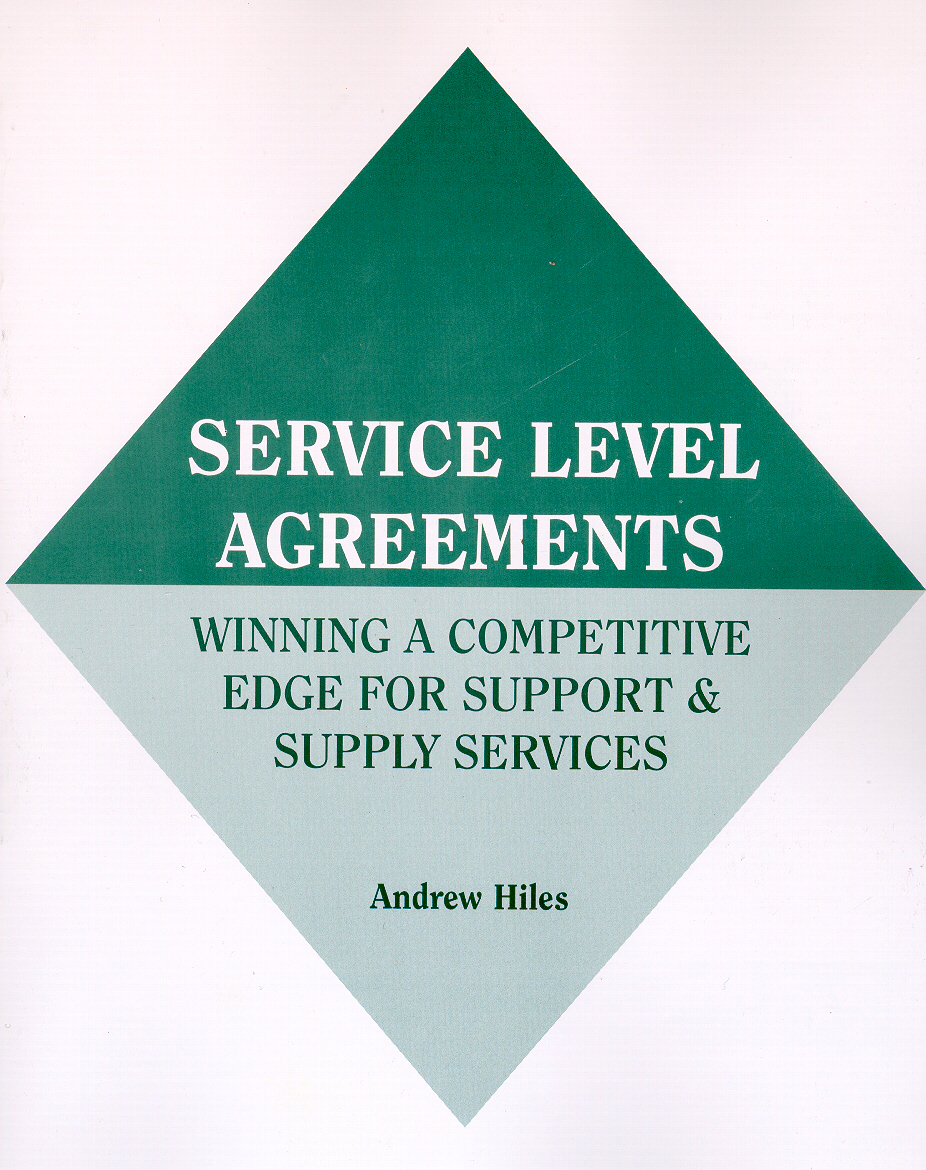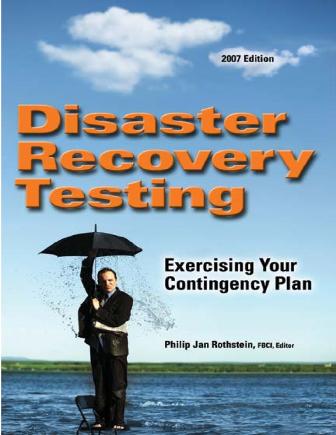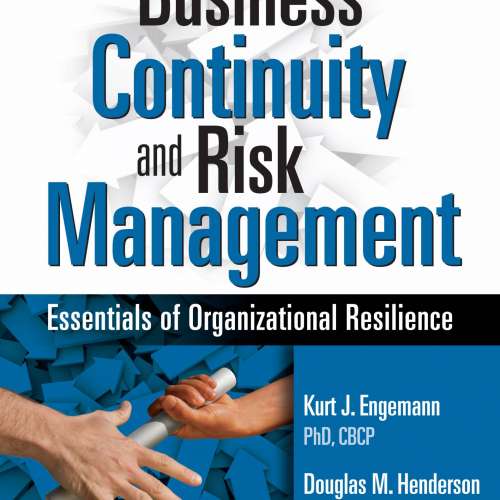Description
A service level agreement is the tool which ensures delivery of consistent, appropriate and timely service quality to meet the business need at the right price.
Frequently new technologies demand new, creative, methods of management. Occasionally these new management models have the potential to enhance the effectiveness of business areas never envisaged when the management method was originally devised: they are transferable.
One of the classic cases is the transfer of engineering management disciplines, for instance quality assurance and quality control (and more recently total quality management – TQM). Quality disciplines have permeated from the factory floor into virtually every area of corporate operations and been universally embraced by world class organizations.
Those first to seize such opportunities gain efficiency, effectiveness and, frequently, competitive edge. But all too often, organizations simply react when they see more alert competitors gaining advantage and the new techniques are implemented merely out of defence. They are used as a band-aid when the cure is a transplant.
The opportunity is rare – to identify and adopt such new concepts for competitive edge. The dynamic world of information services, combining explosive growth with corporate dependence, has had to create new methodologies to contain costs and manage service. One of the key methods employed by the leaders in information services management is the use of service level agreements.
While a contract will govern the legal and commercial aspects of service provision it cannot effectively govern the day-to-day delivery of the service quality — and contracts are irrelevant to in-house service providers.
Many corporate services are overheads — not profit earners, but profit dissipators. How can their cost be controlled — or better, reduced — while preserving acceptable quality?
Using case studies and examples, this book explains how service level agreements, born to meet the challenges of a new industry, can be translated as a practical management tool in any service environment, and provides a blueprint for their implementation.
A Rothstein Publishing Classic Backlist title. 2000, 316 pages.
Contents
ACKNOWLEDGEMENTS. v
- AN OVERVIEW OF SERVICE LEVEL AGREEMENTS: WHAT THEY CAN DO AND CANNOT DO.. 1
1.1 Introduction. 1
1.2 Service Level Agreements : Definition. 3
Figure 1: Pyramid Model of Service. 5
1.3 Serving the Business. 7
1.5 Outsourcing & Facilities Management. 10
1.6 In-Company Vs Outsourcing SLAs: Crucial Differences. 10
1.7 The Role of the SLA in Invitations To Tender, Proposals and Contracts. 11
1.8 SLAs in Market Testing, Outsourcing and Supply / Support Contracts. 11
1.9 Avoiding Hidden Costs – and Identifying Real Needs. 12
1.10 Can SLAs Work in Strategic Partnerships?. 12
1.11 Quality Standards ISO 9004 Part 2. 13
1.12 Availability. 13
1.13 Performance: Speed, Response and Accuracy. 16
1.14 Security. 17
1.15 Quality: Process Control. 17
1.16 Service Products. 18
1.17 Points of Delivery and Delivery Mechanisms. 18
1.18 Service Culture. 18
1.19 But Why SLAs?. 20
CHECKLIST #1: SERVICE ORIENTATION.. 23
- THE MEASUREMENT OF THE SERVICE AVAILABILITY AND QUALITY: KEY METRICS AND TECHNIQUES WHICH MAY BE USED.. 31
2.1 Introduction. 31
2.2 Service Availability. 32
Figure 3: Service Management Methodologies & Service Reporting. 34
2.3 Change Management. 34
2.4 Problem Management. 36
2.5 Critical Component Analysis. 37
2.6 Relationship with Security and Contingency Planning. 40
2.7 Scope of Service. 42
2.8 Service Hours. 43
2.9 Real Time Services. 45
2.10 Background Services. 46
2.11 Administrative Services. 46
2.12 Remote Services. 49
2.13 Subcontracts. 49
2.14 Help Desk and Customer Support. 50
2.15 Security Services. 51
2.16 Special Requirements. 51
2.17 Standardisation. 52
2.18 Customer Self Help. 52
2.19 Training. 52
2.20 Customer Satisfaction Survey. 53
- HOW SERVICE LEVEL AGREEMENTS APPLY IN DEVELOPMENT OR CREATIVE ENVIRONMENTS. 65
3.1 Creative and Development Functions. 65
Figure 4: Embedding Service Level Capability in Development. 68
3.3 Feasibility Study. 69
3.4 Analysis/Specification. 70
3.5 Design. 70
3.6 Invitation to Tender/Contract. 72
3.7 Implementation. 72
3.8 Post-Implementation Review.. 73
3.9 Service Orientation. 73
- KEYS TO MEASURING AND MONITORING SERVICE; DESIGNING AND IMPLEMENTING AN SLA.. 75
4.1 Measuring Performance and Availability. 75
4.2 Balancing Detail with Practicality. 80
4.3 What to Include in a SLA.. 80
4.4 Shell, Template, Model and Standard SLAs. 83
4.5 SLAs and Their Key Role in the Balanced Scorecard. 85
4.5 The Service Handbook. 87
4.6 The One-Page SLA.. 88
Figure 7: Example Service Definition. 89
4.6.2 The One-Page SLA.. 90
Figure 8: A One-Page SLA Format. 90
Figure 9: Service Level Management Components. 92
4.8 Charging for Services. 93
Figure 10: A Charging Methodology. 97
4.9 Infinite Capacity and 100% Availability?. 99
4.10 Realistic Limits to Service. 101
4.11 Procurement. 102
4.12 Organisational Issues. 104
4.13 Pilot Implementation. 110
4.14 Negotiating with the Customer. 112
4.15 Reward and Punishment – Sticks and Carrots. 113
4.16 Reporting Actual Performance against SLA.. 114
Figure 15: Global Service Report – Schematic. 117
Figure 16A: Sample SLA Report. 118
Figure 16B: Background (production type). 119
Figure 17: Measuring Service Components. 120
4.17 Service Review Meetings. 121
4.18 The Customer Review Meeting. 122
4.19 Service Motivation. 123
4.20 Extending SLAs. 124
SERVICE LEVEL SURVEY. 125
SERVICE LEVEL SURVEY. 126
TERMS OF REFERENCE FOR MARKETING AND SALES MANAGER.. 130
TERMS OF REFERENCE FOR CUSTOMER ACCOUNT MANAGERS. 131
THE DOWNSIDE RISK; ALTERNATIVES TO SERVICE LEVEL AGREEMENTS; THE SLA PAYOFF. 133
5.1 SLAs: Reasons for Failure. 133
5.2 Alternatives to SLAs. 135
5.3 Performance Indicators. 136
5.4 Availability and Response Targets. 137
5.5 Benchmark Checks. 140
5.7 The SLA Payoff : Success Stories. 142
5.8 Where Next?. 145
5.9 Conclusion. 146
- CASE STUDIES: SERVICE LEVEL AGREEMENTS. 147
6.1 Introduction. 147
6.2 Payroll and Benefits. 148
6.3 Procurement (Service and Spares). 153
6.4 Logistics / Transport. 154
6.5 Livestock Handling. 155
6.7 Training. 155
Detailed SLA Examples. 158
- CASE STUDY: SERVICE LEVEL AGREEMENT IN CONSTRUCTION MANAGEMENT. 159
7.1 Introduction. 159
7.2 Background. 160
7.3 Construction Management – Typical Approach. 163
7.4 Construction Management – Service oriented approach. 165
7.5 Service Levels in Construction Management. 167
7.6 Identifying Metrics for Management Services. 170
APPENDIX A.. 177
SERVICE LEVEL AGREEMENT CHECKLIST. 177
APPENDIX B.. 197
SAMPLE SLA – ESCALATION PROCEDURE. 197
APPENDIX C. 215
STANDARD SLA FORMAT. 215
BIBLIOGRAPHY. 281
ABOUT THE AUTHOR.. 283
About the Author
Andrew Hiles is a Fellow of the Business Continuity Institute and a Member of the British Computer Society. Andrew was founder Chairman of the influential European Information Market (EURIM) group which supports the UK Parliament’s All-Party EURIM Group in handling European legislation. His first book on Service Level Management was published in 1991; his second book in 1993. He contributed to Croner’s Guide to IT Purchasing. His software package, SLA FRAMEWORKâ„¢, has been purchased by leading international companies.
Starting his I.T. career with the Royal Air Force in programming and systems, Andrew moved to London Transport in an operational role. Later, in their Central Productivity Unit and subsequently as I.T. Projects Manager and as Manager of the Business Process Re-engineering function, he led several major technical and organisational reviews involving the reorganisation of key functions of London Transport. From there he moved to the Post Office as their first Business Systems Consultant with responsibilities for major projects. Subsequently as Computer Services Manager at Harwell Laboratory h e provided supercomputing, mainframe, midrange and client / server bureau services and operational support of mainframe and midrange installations that Harwell facility managed. He also had Customer Support and Quality Assurance responsibilities for the Datacenter.
e provided supercomputing, mainframe, midrange and client / server bureau services and operational support of mainframe and midrange installations that Harwell facility managed. He also had Customer Support and Quality Assurance responsibilities for the Datacenter.
Andrew is a Director of the Kingswell Partnership of I.T. Consultants – an international consultancy specialising in delivering service and managing business risk. He has helped hi-tech, financial, transport and government bodies to develop and enhance Customer Support and Service Desk functions and has supported both customers and suppliers in Service Level Agreements, Market Testing, Outsourcing and Facilities Management.
Andrew is a published writer and international speaker on service management. He has presented at Cranfield, Henley, Ashridge and GEC Management Colleges and at numerous conferences in Europe, USA, Southern Africa, the Middle East, Hong Kong, the Philippines and New Zealand and Australia. He has broadcast on IT topics on radio and television.
Excerpt from the Introduction
We take service departments for granted – or at least, we used to: Personnel; Accounts; Purchasing; Stores; Legal; Catering; Training; Estates; Facilities Management; Cleaning; Secretariat; Engineering; Public Relations – all those and more may be part of our business infrastructure.
Increasingly, in-company services are seen as utility services just like electricity or water. These days, utilities world-wide have increasingly become privatized -expected to fund themselves as commercial entities rather than be provided by governments. Similarly, the cost of our organization’s support services is increasingly challenged. Value for money is being insisted upon – but how do you measure it? In-company services are increasingly expected to be self-sufficient, at least recovering costs from customers, rather than being provided as a corporate service as part of the overhead costs.
With the supply of any utility, the customer expects a defect-free service, available 100% of the time, at a reasonable cost. A utility service implies a limited range of standard products – but this may be in direct conflict with the increasing technological or legal complexity with which the service supplier has to cope in supporting customer demands for a greatly increasing range of services. The service supplier is often trying to cover too much ground with too few resources: the supplier needs to standardize and prioritize service offerings.
Often this ‘utility’ logic is not extended to the provision of in-company services. You know what the tariff rate is for power, gas, fuel oil and all the other utilities. The price may depend upon your negotiating power – but you know what you are getting for your money. You can measure the consumption of these services in terms of efficiency and select the appropriate quality – premium unleaded gasoline for instance. Your organization specifies the quality it requires for any consumable that it uses. This makes sense: buying goods of a higher quality than you need wastes money. Support services are overheads – and typically it can take up to ten million dollars of sales to cover the cost of one million dollars of overheads. A look at your profit margins on turnover will illustrate this.
When the in-company service was first established, its size and scope was agreed upon. Its capacity was defined and throughput requirements may also have been stated. But there are many other aspects of the service that frequently are not quantified. Often the service requirement has not been recently checked back with the customer so that the changing customer requirements may not be expressed in the current service specification. The service provider may be faced with increased demand and no additional resource to cover it.
All this can lead to a miss-match of expectations between the end customers and the support service provider. The end customer perceives that the service is ‘poor’. Response to requests may be ‘slow’. Support may be ‘patchy’. All these are unquantified – but they suggest a background noise of customer dissatisfaction with the service – especially vocal if the end user is a paying customer. It is all too easy for the service manager to assume the customer’s perception is wrong: it cannot be wrong! It is the customer’s perception and will remain so until it is changed.
The service manager, being frequently more analytical than the customer, will doubtless be measuring certain aspects of the service which are perceived as key performance indicators. As long as these are at worst consistent and at best improving, the service manager may believe that a good service is being provided.
This service may not however be what the customer wants! So how do we align the service to the needs of its customers?
Reviews
“Service level agreements are an essential element in the provision of an appropriate and timely service to business. Andrew Hiles’ approach is easy to understand and of practical use to both users and providers.” – Graham F. Roulstone, Services Manager, Blue Circle Industries, PLC, UK
===================================
“An ever-increasing number of companies are becoming aware of the need to maximize customer satisfaction, and the consequent need to quantify and measure service functions. This book demonstrates how this can be achieved.” – W. Adrian Smyth, Director and General Manager, COTEC Computer Services, UK
===================================
“The concept of service level agreements for all businesses is a topic whose time has come. This book is a complete blueprint on the subject.” – Paul F. Kirvan, Management Consultant, Paul F. Kirvan Associates, USA.


 e provided supercomputing, mainframe, midrange and client / server bureau services and operational support of mainframe and midrange installations that Harwell facility managed. He also had Customer Support and Quality Assurance responsibilities for the Datacenter.
e provided supercomputing, mainframe, midrange and client / server bureau services and operational support of mainframe and midrange installations that Harwell facility managed. He also had Customer Support and Quality Assurance responsibilities for the Datacenter.

